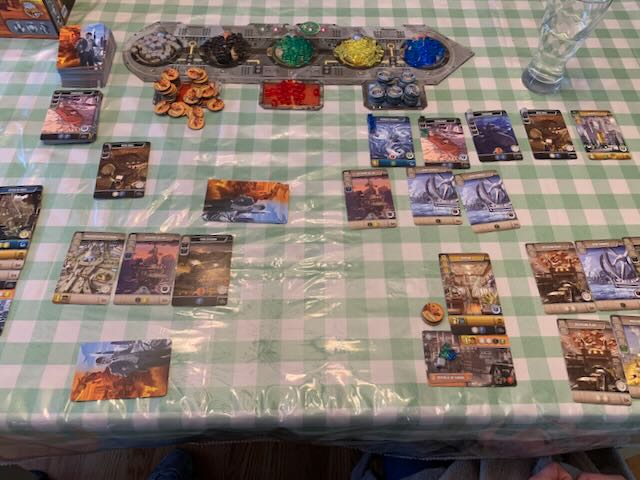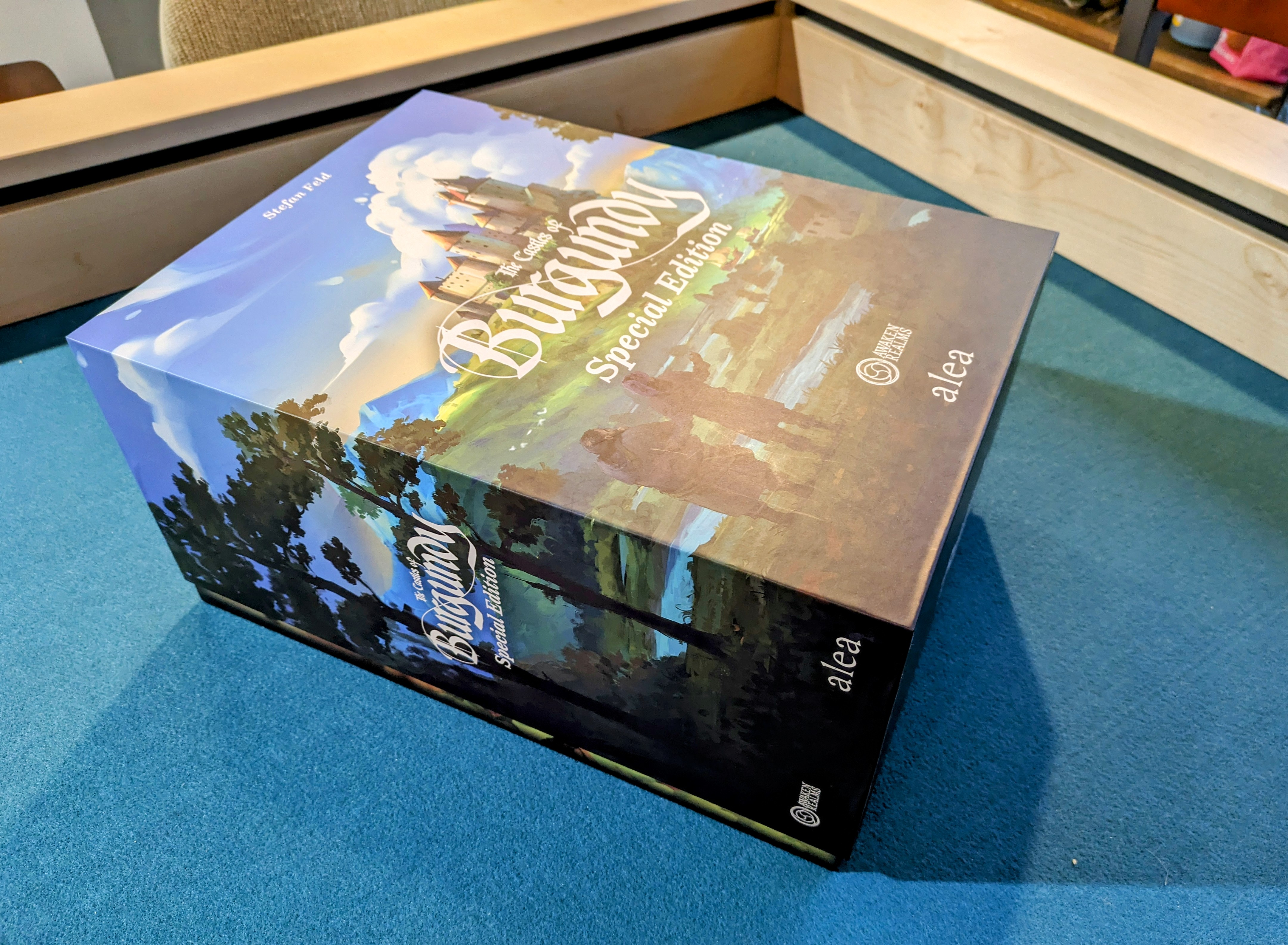
Engine building games are hit or miss with me. Splendor and Gizmos, miss. Wingspan and Terraforming Mars Ares Expedition, hit. I think what makes the latter succeed for me is the sense of accomplishment when you get to the end game and realize how far you have come. It’s a Wonderful World looks like it might hit as an engine builder because of a couple of unique wrinkles. Card drafting and linear production. I will admit, this game had flown under my radar and did not really interest me until one of my buddies started talking it up. That same friend dropped a copy on me for my birthday. Unfortunately I was not able to get it to the table that day but hey, that is what game groups are for.
It’s a Wonderful World Overview
It’s a Wonderful World is a game for 1-5 players designed by Frederic Guerard and published by Lucky Duck Games. In the game players will take control of an empire to draft, construct, and produce their way to victory. The player with the most points at the end of 4 rounds will be declared the winner.
Setup
It’s a Wonderful World has a fairly quick set up. The 2 piece production track is set up and colored cubes are placed on each of the circles of the corresponding color. Banker and General tokens are placed under the left and right sides of the board. The red wild cubes (Krystallium) are placed under the board in the center. Deal every player an empire card and as a group choose to play side A or B. Shuffle up the deck of development cards and place them above the board to the left. Finally, deal each player 7 of these development cards and you are ready to play.
It’s a Wonderful World Gameplay
A game of It’s a Wonderful World is played out over 4 rounds with each round consisting of 3 phases. Drafting, Planning, and Production.
With the first pick . . .

During the drafting phase you and the other players will take turns selecting one card from your hand and passing the remaining to the player on the left of right depending on the round. When you receive the next set of cards from your neighbor, you select another card and pass the rest. This continues until all cards are drafted by the players.
When drafting there are several icons on a card that you want to pay attention to as they will dictate your strategies in the planning and production phases:
- Construction Costs (Upper Left) – These are the resources that are needed to build the card and put it in you empire.
- Victory Points (Bottom Left) – Point that will be awarded at the end of the game if the card is in your empire.
- Recycle Bonus (Right Side) – These are the resources that will be awarded to you if you decide to recycle the card.
- Card type (Bottom Right) – One of the 5 types of development that a card can be classified as.
- Construction Bonus (Middle) – The one time bonus that is received when constructing a card
- Production – (Bottom Middle) – The resources this card will generate when in your empire.
The cards that are drafted during this phase are crucial heading into the planning phase.
The best laid plans . . .
During the planing phase players have a decision to make for each card they have drafted. You can slate a card for construction. Cards under construction will be able to have resource cubes placed on them to “build” the card. Once all resources are acquired for the card, the card is considered built and stacks vertically on top of your empire card adding to your empire’s production and collecting any bonuses for construction.
You could also recycle the card. Recycling will give resources that could help you build cards that are already under construction. Once resources are collected for recycled cards those cards are then discarded and taken out of play. All cards that were drafted in the previous phase must be slated for construction or recycling before heading to the next phase, production.
Building the machine
Production in It’s a Wonderful World has a unique twist. Each resource is produced independently and sequentially. Players will progress as a group from left to right producing each resource based on cards stacked in your empire. Each time a resource is produced, a Banker or General reward is given for the top producer. You can also complete construction of cards in between each production phase.
The way this is executed gives this cool little assembly line feel that lets players pull off production combos. Producing goods at the start of the line, if played correctly, can build cards that can be added to gain more production at the end of the line. You also need to pay close attention to cards during this phase as some production is based off of the types of cards in your empire. After all steps of production are complete the next round starts and it is back to drafting again.

End Game Scoring
Once 4 rounds are complete players will move to end game scoring. Players will be scoring combinations of the tokens they have collected, point values, multipliers, and types of cards they have built. It is mathy, but not overly complicated. The player with the most points has created the most wonderful world!
It’s a Wonderful World Impressions
Components
Components in It’s a Wonderful World are good. I would say on par with moden games today, not over produced. Card art is cool and has a sci-fi, cold war feel to it. I enjoyed reading and studying the cards I was drafting. The board is super unique and does a great job of naturally aiding in how production should flow. They could have just not had a board with the game but I appreciate that it is here. I do kind of wish that there was something for holding all the cubes and a better insert but these are small gripes.
Gameplay

I really like this game. The best way I can describe this game is if you took parts of 7 Wonders, Century Spice Road, and Terraforming Mars Ares Expedition and put them together this is what you would get. It all works together pretty well and it is great planning out your drafts and playing to your empire and the cards you have constructed. As with all drafting games there will be hate drafting but honestly there are many routes to victory and it does not feel as bad when the cards come back around and the other card you wanted is not there. Production has a unique twist and adds to the planning. It is super satisfying when you pull off that combo during production that lets you build a couple of extra cards and produce a few more resources.
Normally, I am not an AP type person but this can be a very analytical game. There are lots of decisions here. Pouring over the information on the cards while drafting. Deciding which ones to recycle and which ones to build. How to progress on production. How to build victory points along the way. This game is a sneaky brain burner.
Accessibility
The game plays typically in under an hour thanks in large part to the simultaneous play. I don’t think I would bring this game out to brand new gamers, this sits in a gateway+ area to me. Cards, while busy are easily readable once you get the hang of the game. With expansion this game will play 7 so no one will be sitting on the sidelines and I think you could play this with the younger crowd. Maybe 10-11 year olds but I don’t think much younger than that. The game is fairly easy to set up and get to the table and would make for a good opener to a game night.
Final Verdict of It’s a Wonderful World

Man, I need to start adding half stars, this game is a 4 1/2 for me. Honesty, this game is super underrated. It has started to replace a couple of games in my collection. The combination of mechanics works really well and there is quite a bit of game packed into a sub 1 hour play time. When playing with friends in my gaming group after the first play they wanted to try it again next time, a sign of a good game to me. If you like 7 Wonders, Terraforming Mars Ares Expedition, or Century Spice Road, check this game out.






Leave a Comment